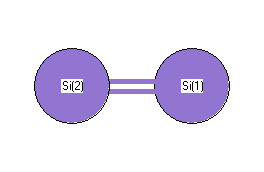Jump to
S2C1
Energy calculated at TPSSh/cc-pVTZ
| | hartrees |
|---|
| Energy at 0K | -578.895124 |
| Energy at 298.15K | -578.893827 |
| HF Energy | -578.895124 |
| Nuclear repulsion energy | 48.042751 |
The energy at 298.15K was derived from the energy at 0K
and an integrated heat capacity that used the calculated vibrational frequencies.
Geometric Data calculated at TPSSh/cc-pVTZ
Point Group is D∞h
Cartesians (Å)
| Atom |
x (Å) |
y (Å) |
z (Å) |
|---|
| Si1 |
0.000 |
0.000 |
1.077 |
| Si2 |
0.000 |
0.000 |
-1.077 |
Atom - Atom Distances (Å)
| |
Si1 |
Si2 |
| Si1 | | 2.1549 |
Si2 | 2.1549 | |
 More geometry information
More geometry information
Electronic energy levels
Charges, Dipole, Quadrupole and Polarizability
Jump to
S1C1
Energy calculated at TPSSh/cc-pVTZ
| | hartrees |
|---|
| Energy at 0K | -578.857981 |
| Energy at 298.15K | -578.856720 |
| HF Energy | -578.857981 |
| Nuclear repulsion energy | 50.399863 |
The energy at 298.15K was derived from the energy at 0K
and an integrated heat capacity that used the calculated vibrational frequencies.
Geometric Data calculated at TPSSh/cc-pVTZ
Point Group is D∞h
Cartesians (Å)
| Atom |
x (Å) |
y (Å) |
z (Å) |
|---|
| Si1 |
0.000 |
0.000 |
1.028 |
| Si2 |
0.000 |
0.000 |
-1.028 |
Atom - Atom Distances (Å)
| |
Si1 |
Si2 |
| Si1 | | 2.0561 |
Si2 | 2.0561 | |
 More geometry information
More geometry information
Electronic energy levels
Charges, Dipole, Quadrupole and Polarizability
Charges from optimized geometry at TPSSh/cc-pVTZ
Charges (e)
| Number |
Element |
Mulliken |
CHELPG |
AIM |
ESP |
| 1 |
Si |
0.000 |
|
|
|
| 2 |
Si |
0.000 |
|
|
|
Electric dipole moments
Electric dipole components in Debye
(What's a Debye? See section
VII.A.3)
| |
x |
y |
z |
Total |
| |
0.000 |
0.000 |
0.000 |
0.000 |
| CHELPG |
|
|
|
|
| AIM |
|
|
|
|
| ESP |
|
|
|
|
Electric Quadrupole moment
Quadrupole components in D Å
Polarizabilities
Components of the polarizability tensor.
Units are
Å
3 (Angstrom cubed)
Change units.
| |
x |
y |
z |
| x |
0.000 |
0.000 |
0.000 |
| y |
0.000 |
0.000 |
0.000 |
| z |
0.000 |
0.000 |
0.000 |
<r2> (average value of r
2) Å
2
| <r2> |
45.465 |
| (<r2>)1/2 |
6.743 |
